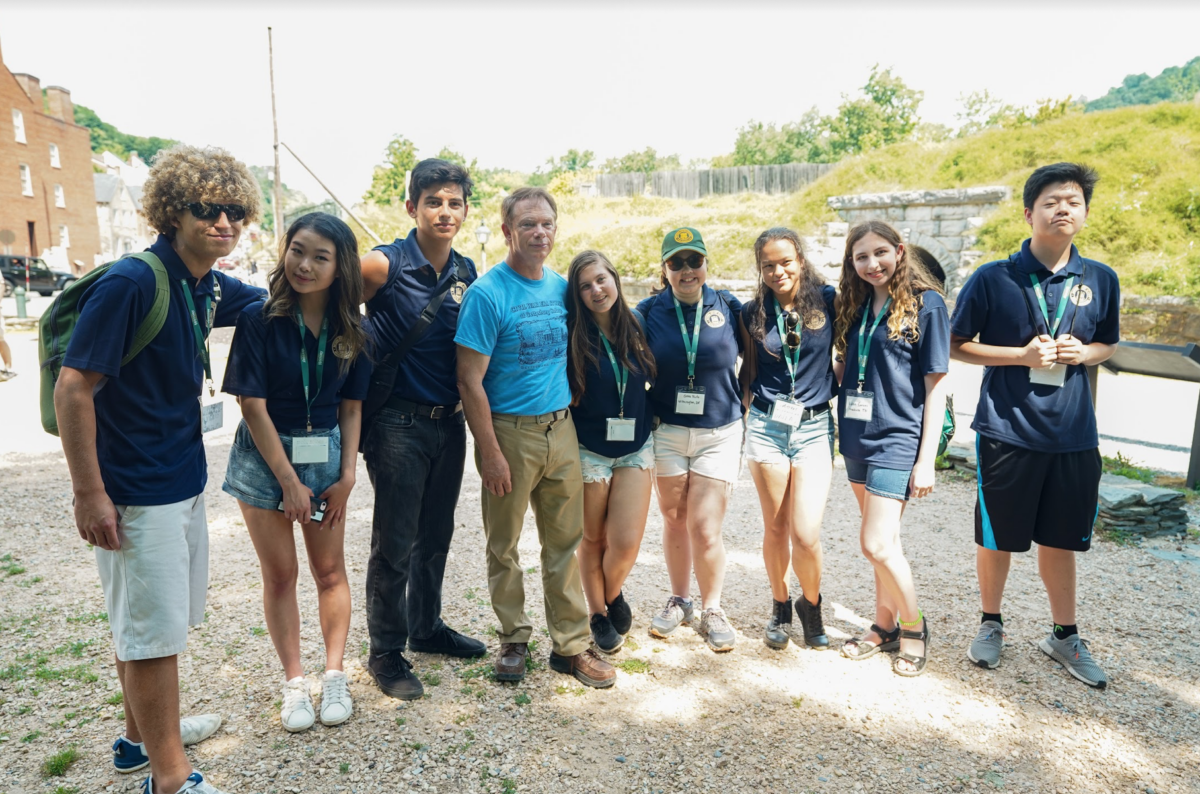Hi all, Gina Rufo again. Thank you for the positive feedback on my last post about Montpelier! This blog post is dedicated to recalling our trip to Harper’s Ferry and the things that Dennis Frye (who I have been fortunate enough to contact in preparation for writing this) taught us about the actions of John Brown on that night. First and foremost I would like to share the path of John Brown–a path that we followed. Now, imagine this: it is 1859 and there is only one bridge across the Potomac River. (we walked along a more modern bridge (made in 1894) that was parallel to the ruins that the bridge had sat atop.) Brown and his initial “army” of 18 men cross that bridge from Maryland at around 10:45 pm on Sunday, October 16th, 1859. “The single greatest danger to the bridge was sparks from locomotives, so a fireman was assigned watch.” (Dennis Frye) this single fireman ends up being seized at the bridge. Brown and his men then proceed on what is now the West Virginia but at the time had been Virginia, side of the bridge, where they rushed the US Armory. Here they seize another fireman/watchman. Their plan? To raid the arsenal and provide slaves with weapons necessary to protect themselves. Brown now has possession of both the armory and the arsenal, but this is where his plan begins to go askew. The bridge watchman escapes and manages to flag down a passenger train at around 1:15 am on Monday. This is an obvious issue for John Brown; if he allows the train to depart, word of his siege will get out and his plan will be foiled. Shortly before dawn, though, he lets the train go and soon word arrives in Washington about the attack.
President Buchanan orders for US Marines to storm Harper’s Ferry to take down the rebels. Buchanan sends the marines to the armory fire house (Brown’s temporary headquarters), where the first marine, a man by the name Israel Greene crawls through a breech in the door big enough for one man and under a stationed fire truck that blocked the entrance. While Brown and his men hide out and discuss their next movements, Greene is able to crawl into the building undetected. The first person he sees when he emerges in the fire house is John Brown. Greene does not know Brown, but knows that he is the enemy and thrusts his sword at him. Remarkably, John Brown is left uninjured, as the sword does not penetrate because the blade struck a brass breast plate Brown is wearing. Unfortunately, Brown’s luck runs out, as Greene quickly decides to use the hilt of his sword as a club and beats Brown unconscious. Brown is captured, removed, and brought to Charles Town where he is tried not on a federal level, but by the state of Virginia which finds him guilty of treason with the intention of leading a slave rebellion. Had he been tried by the federal government or in the North where his actions were seen as pretty heroic, perhaps Brown would have been let go or given a jail sentence. Since he was tried by Virginia, though, he was executed by hanging on December 2nd, 1859. While my classmates, teachers, and I walked the grounds of Harper’s Ferry and listened to the remarkable Dennis Frye describe the events of that evening, I found a great irony in the fact that the first casualty of the raid was Hayward Shepherd, a baggage porter for the railroad and free black man who was prematurely shot while attempting to determine why the train hadn’t made it to the station on time.
While the day of our tour was hot (as many of ours have been considering its Virginia in July), it was abundantly clear that no amount of heat could distract us from the knowledge we were being fed by Mr. Frye. From seeing the oldest railroad in the United States, to seeing how the town itself was able to maintain the façade of timelessness that I so admire as they prepared to celebrate their anniversary, everyone on our tour was completely enthralled. We were even able to stand on the ruins of a Civil War hospital as the river crashed and turned below the soles of our shoes and the sun beat down on us. The hospital was left to ruins long after the Civil War due to flooding, but while its walls may not stand upright the stories of those who suffered and died there from their injuries and disease could be felt. As we were asked to put ourselves in the shoes of a citizen of America at the time of the raid we were proposed the question: “Would you follow Brown?” and I extend that question to all of you. Me, personally, I decided that I would not have followed Brown. In my opinion, his actions, while effective, were radical and driven by emotion and I would have much rather used my words and tried to appeal to the human emotion rather than resort to violence. So, there is the story of Harper’s Ferry and the path of John Brown and his men. Though I have done my research and talked with my peers, the question of Brown’s morality still troubles me. In my personal opinion as a hopeful historian and novelist, I believe that history is neither black nor white but entirely gray. Every person and event is absolutely devoid of color; nothing is full good or full bad and it is for that exact reason that I hope to educate others on the humanity of history, because if we continue to let our emotions determine our recall of events, history will never be recorded accurately.
